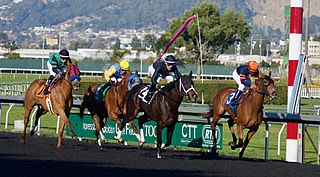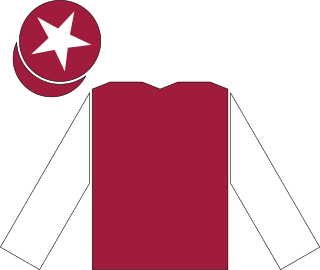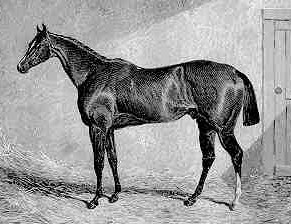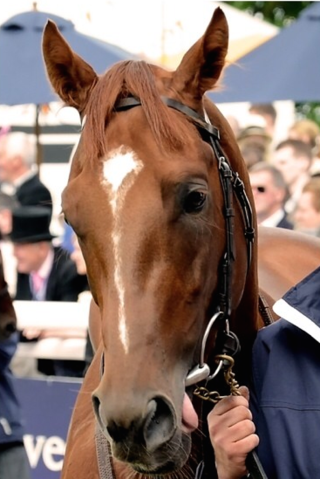
Parimutuel betting or pool betting is a betting system in which all bets of a particular type are placed together in a pool; taxes and the "house-take" or "vigorish" are deducted, and payoff odds are calculated by sharing the pool among all winning bets. In some countries it is known as the tote after the totalisator, which calculates and displays bets already made.
Fixed-odds betting is a form of gambling where individuals place bets on the outcome of an event, such as sports matches or horse races, at predetermined odds. In fixed-odds betting, the odds are fixed and determined at the time of placing the bet. These odds reflect the likelihood of a particular outcome occurring. If the bettor's prediction is correct, they receive a payout based on the fixed odds. This means that the potential winnings are known at the time of placing the bet, regardless of any changes in the odds leading up to the event.

Thoroughbred racing is a sport and industry involving the racing of Thoroughbred horses. It is governed by different national bodies. There are two forms of the sport – flat racing and jump racing, the latter known as National Hunt racing in the UK and steeplechasing in the US. Jump racing can be further divided into hurdling and steeplechasing.

Horse racing is an equestrian performance activity, typically involving two or more horses ridden by jockeys over a set distance for competition. It is one of the most ancient of all sports, as its basic premise – to identify which of two or more horses is the fastest over a set course or distance – has been mostly unchanged since at least classical antiquity.

Horse racing is the second largest spectator sport in Great Britain, and one of the longest established, with a history dating back many centuries. According to a report by the British Horseracing Authority it generates £3.39 billion total direct and indirect expenditure in the British economy, of which £1.05 billion is from core racing industry expenditure, and the major horse racing events such as Royal Ascot and Cheltenham Festival are important dates in the British and international sporting and society calendar.

Thoroughbred horse racing is a spectator sport in Australia, and gambling on horse races is a very popular pastime with A$14.3 billion wagered in 2009/10 with bookmakers and the Totalisator Agency Board (TAB). The two forms of Thoroughbred horseracing in Australia are flat racing, and races over fences or hurdles in Victoria and South Australia. Thoroughbred racing is the third most attended spectator sport in Australia, behind Australian rules football and rugby league, with almost two million admissions to 360 registered racecourses throughout Australia in 2009/10. Horseracing commenced soon after European settlement, and is now well-appointed with automatic totalizators, starting gates and photo finish cameras on nearly all Australian racecourses.

Handicapping, in sport and games, is the practice of assigning advantage through scoring compensation or other advantage given to different contestants to equalize the chances of winning. The word also applies to the various methods by which the advantage is calculated. In principle, a more experienced participant is disadvantaged, or a less experienced or capable participant is advantaged, in order to make it possible for the less experienced participant to win whilst maintaining fairness. Handicapping is used in scoring many games and competitive sports, including go, shogi, chess, croquet, golf, bowling, polo, basketball, and track and field events. Handicap races are common in clubs which encourage all levels of participants, such as swimming or in cycling clubs and sailing clubs, or which allow participants with a variety of standards of equipment. Often races, contests or tournaments where this practice is competitively employed are known as Handicaps.
Fine Cotton was a brown Australian Thoroughbred gelding which was at the centre of a substitution scam which occurred on 18 August 1984, in the Commerce Novice Handicap over 1,500 metres at Eagle Farm Racecourse, Brisbane, Queensland. Although there have been many ring-ins and other illegal scams in Australian racing, the Fine Cotton scandal is infamous in Australia due to the involvement of some of racing's elite.
A pick 6 is a type of wager offered by horse racing tracks. It requires bettors to select the winners of six consecutive races. Because of the great difficulty in picking six straight winners, plus the number of betting interests involved, payoffs for successful wagers are quite high, sometimes in the millions of dollars.

The Tote is a British gambling company founded in 1928. It operates the world’s largest online pool betting website. Its product offering also includes sports betting and online casino. Business operations are led from its headquarters in Wigan.
Virtual racing is an offering from the "Big Four" bookmakers in the United Kingdom, along with some smaller firms. They offer punters the opportunity to place a wager on racing even after the day's race coverage, then watch the race on a TV screen. The races include virtual dog racing and virtual horse racing.

Oh So Sharp (1982–2001) was an Irish-bred, British-trained Thoroughbred racehorse best known for winning the English Fillies' Triple Crown in 1985. In a racing career which lasted from August 1984 until September 1985, she won seven of her nine races, starting favourite on each occasion and never at odds of more than 2/1. She was one of the leading two-year-old fillies of 1984 when she was unbeaten in three races, including the Fillies' Mile. In the following year Oh So Sharp won the 1000 Guineas in record time and then took the Oaks by six lengths before being narrowly beaten in her next two starts in major weight-for-age races. The filly completed the Triple Crown in the St Leger Stakes. She was retired at the end of the season and became a successful broodmare. Oh So Sharp died in 2001 at the age of nineteen.

George Elsworth Smith was an American gambler and Thoroughbred horse racing enthusiast who became a multi-millionaire during the late nineteenth and early twentieth century. Smith was given the nickname "Pittsburgh Phil" in 1885 by Chicago gambler William "Silver Bill" Riley to differentiate him from the other Smiths that also frequented Riley's pool halls. Pittsburgh Phil is considered by many handicappers to have been an expert strategist, winning large sums of money at a time when racing statistic publications, such as The Daily Racing Form, were not widely available. At the time of his death from tuberculosis in 1905, he had amassed a fortune worth $3,250,000, which is comparable to $US 110,211,111 today. His racing Maxims, published posthumously in 1908, are considered to be the foundations of many modern handicapping strategies and formulas.
The following is a glossary of North American horse racing.

Spaniel (1828–1833) was a British Thoroughbred racehorse. In a career that lasted from July 1830 to early 1833 he ran eighteen times and won nine races. After an unsuccessful season as a two-year-old he made significant improvement in 1831 to win his first three races, culminating in The Derby. Spaniel failed to win again for over a year but then recovered to win five races on Welsh racecourses in 1832. He died after being injured on his first start as a five-year-old in 1833.

Petrarch was a British Thoroughbred racehorse and sire who won two British Classic Races in 1876. In a career that lasted from October 1875 to October 1878 he ran sixteen times and won eight races. In 1875, Petrarch won the Middle Park Stakes on his only appearance of the season. As a three-year-old in 1876 he won two of the three races which comprise the Triple Crown, taking the 2000 Guineas at Newmarket and the St Leger at Doncaster. He finished unplaced when favourite for The Derby. As a four-year-old he won three races including the two and a half mile Ascot Gold Cup which at that time was regarded as the most important weight-for-age race in the world. Petrarch was regarded by contemporary experts as a brilliant, but inconsistent performer. After winning once as a five-year-old in 1878 he was retired to stud where he became a successful sire of winners.

Australia is an Irish-bred, Thoroughbred racehorse best known for winning the 2014 Epsom Derby. As a two-year-old in 2013, he won two of his three races, creating a very favourable impression when winning the Breeders' Cup Juvenile Turf Trial Stakes, and was highly regarded by his trainer Aidan O'Brien. In May 2014 he finished third behind Night of Thunder and Kingman in the 2000 Guineas before winning the Epsom Derby on 7 June. He subsequently won the Irish Derby and International Stakes before being defeated by The Grey Gatsby in the Irish Champion Stakes. His racing career was ended by injury in October 2014. He is standing at Coolmore stud.

Betting on horse racing or horse betting commonly occurs at many horse races. Modern horse betting started in Great Britain in the early 1600s during the reign of King James I. Gamblers can stake money on the final placement of the horses taking part in a race. Gambling on horses is, however, prohibited at some racetracks. For example, because of a law passed in 1951, betting is illegal in Springdale Race Course, home of the nationally renowned Toronto-Dominion Bank Carolina Cup and Colonial Cup Steeplechase in Camden, South Carolina.
Sonnyboyliston is an Irish Thoroughbred racehorse. He made no impact as a two-year-old and was gelded before returning in 2020 to win three handicap races. He improved to become a top-class stayer as a four-year-old in 2021, winning the Martin Molony Stakes, Ebor Handicap and Irish St Leger.

Modern Games is a retired champion Thoroughbred racehorse. Bred in Ireland and trained in Great Britain, he was one of the best two-year-olds in the world in 2021 when he won four of his six races including the Somerville Tattersall Stakes in England and the Breeders' Cup Juvenile Turf in the United States. As a three-year-old he was victorious in the Group 1 Poule d'Essai des Poulains and Grade I Woodbine Mile and Breeders' Cup Mile, earning him honors as Champion Turf Male of 2022. He finished his racing career with eight victories, winning five Group/Grade One events and either winning or placing in ten graded races.





















